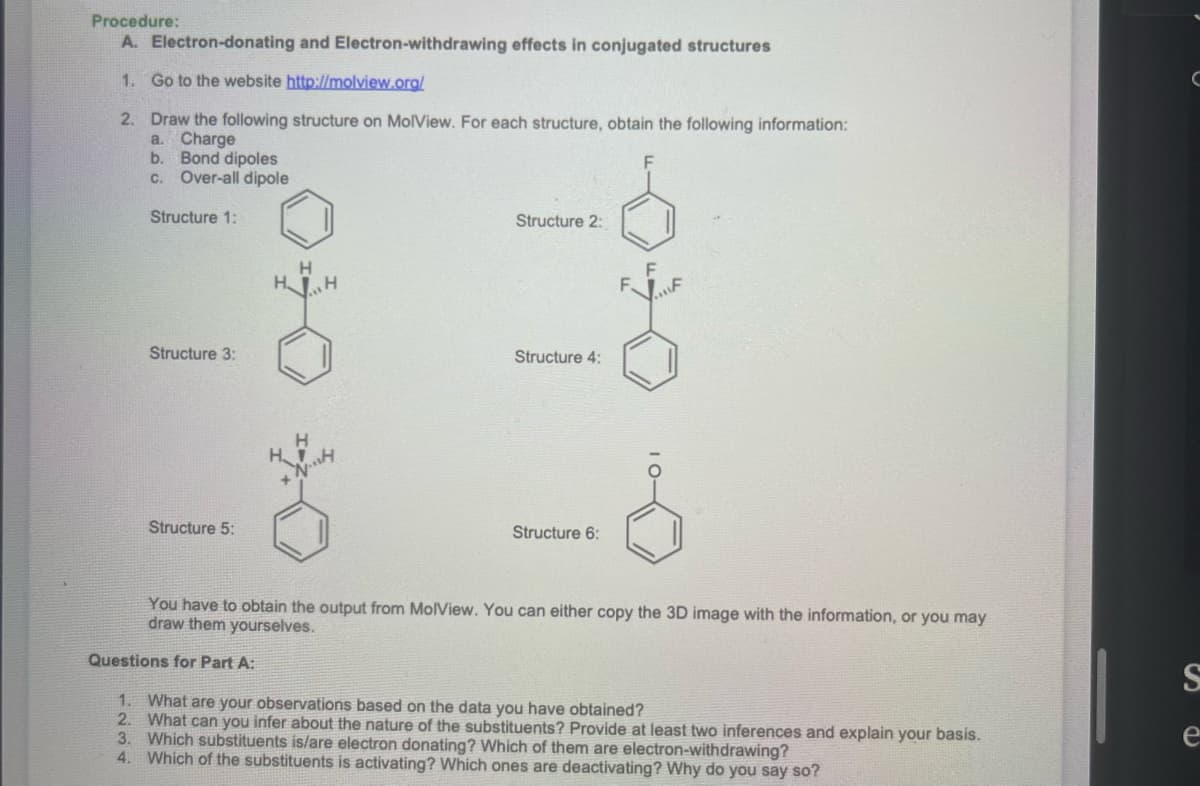Procedure: A. Electron-donating and Electron-withdrawing effects in conjugated structures 1. Go to the website http://molview.org/ 2. Draw the following structure on MolView. For each structure, obtain the following information: a. Charge b. Bond dipoles C. Over-all dipole Structure 1: Structure 2: H. HH Structure 3: Structure 4: Structure 5: Structure 6: You have to obtain the output from MolView.. You can either copy the 3D image with the information, draw them yourselves. you may Questions for Part A: 1. What are your observations based on the data you have obtained? 2. What can you infer about the nature of the substituents? Provide at least two inferences and explain your basis. 3. Which substituents is/are electron donating? Which of them are electron-withdrawing? 4. Which of the substituents is activating? Which ones are deactivating? Why do you say so?
Procedure: A. Electron-donating and Electron-withdrawing effects in conjugated structures 1. Go to the website http://molview.org/ 2. Draw the following structure on MolView. For each structure, obtain the following information: a. Charge b. Bond dipoles C. Over-all dipole Structure 1: Structure 2: H. HH Structure 3: Structure 4: Structure 5: Structure 6: You have to obtain the output from MolView.. You can either copy the 3D image with the information, draw them yourselves. you may Questions for Part A: 1. What are your observations based on the data you have obtained? 2. What can you infer about the nature of the substituents? Provide at least two inferences and explain your basis. 3. Which substituents is/are electron donating? Which of them are electron-withdrawing? 4. Which of the substituents is activating? Which ones are deactivating? Why do you say so?
Chemistry
10th Edition
ISBN:9781305957404
Author:Steven S. Zumdahl, Susan A. Zumdahl, Donald J. DeCoste
Publisher:Steven S. Zumdahl, Susan A. Zumdahl, Donald J. DeCoste
Chapter1: Chemical Foundations
Section: Chapter Questions
Problem 1RQ: Define and explain the differences between the following terms. a. law and theory b. theory and...
Related questions
Question
Please answer number 4

Transcribed Image Text:Procedure:
A. Electron-donating and Electron-withdrawing effects in conjugated structures
1. Go to the website http://molview.org/
2. Draw the following structure on MolView. For each structure, obtain the following information:
a. Charge
b. Bond dipoles
c. Over-all dipole
Structure 1:
Structure 2:
H H
Structure 3:
Structure 4:
Structure 5:
Structure 6:
You have to obtain the output from MolView. You can either copy the 3D image with the information, or you may
draw them yourselves.
Questions for Part A:
S
1. What are your observations based on the data you have obtained?
2. What can you infer about the nature of the substituents? Provide at least two inferences and explain your basis.
3. Which substituents is/are electron donating? Which of them are electron-withdrawing?
4. Which of the substituents is activating? Which ones are deactivating? Why do you say so?
e
Expert Solution
This question has been solved!
Explore an expertly crafted, step-by-step solution for a thorough understanding of key concepts.
Step by step
Solved in 2 steps with 6 images

Knowledge Booster
Learn more about
Need a deep-dive on the concept behind this application? Look no further. Learn more about this topic, chemistry and related others by exploring similar questions and additional content below.Recommended textbooks for you

Chemistry
Chemistry
ISBN:
9781305957404
Author:
Steven S. Zumdahl, Susan A. Zumdahl, Donald J. DeCoste
Publisher:
Cengage Learning

Chemistry
Chemistry
ISBN:
9781259911156
Author:
Raymond Chang Dr., Jason Overby Professor
Publisher:
McGraw-Hill Education

Principles of Instrumental Analysis
Chemistry
ISBN:
9781305577213
Author:
Douglas A. Skoog, F. James Holler, Stanley R. Crouch
Publisher:
Cengage Learning

Chemistry
Chemistry
ISBN:
9781305957404
Author:
Steven S. Zumdahl, Susan A. Zumdahl, Donald J. DeCoste
Publisher:
Cengage Learning

Chemistry
Chemistry
ISBN:
9781259911156
Author:
Raymond Chang Dr., Jason Overby Professor
Publisher:
McGraw-Hill Education

Principles of Instrumental Analysis
Chemistry
ISBN:
9781305577213
Author:
Douglas A. Skoog, F. James Holler, Stanley R. Crouch
Publisher:
Cengage Learning

Organic Chemistry
Chemistry
ISBN:
9780078021558
Author:
Janice Gorzynski Smith Dr.
Publisher:
McGraw-Hill Education

Chemistry: Principles and Reactions
Chemistry
ISBN:
9781305079373
Author:
William L. Masterton, Cecile N. Hurley
Publisher:
Cengage Learning

Elementary Principles of Chemical Processes, Bind…
Chemistry
ISBN:
9781118431221
Author:
Richard M. Felder, Ronald W. Rousseau, Lisa G. Bullard
Publisher:
WILEY